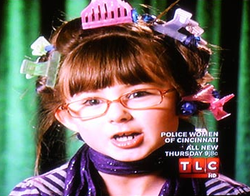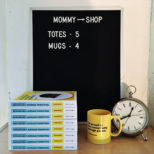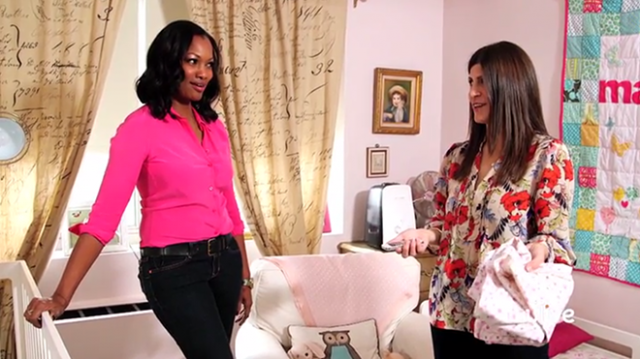 When I was little, I hated hair in my face. I am cursed with a small forehead (this is the part where you look at my face and say— Oh yeeeeaah… you DO have a small forehead!) so my hair blocks my line of vision easily. Thus, I spent much of my childhood, attacking my head with various barrettes in an attempt to avoid walking into walls.
When I was little, I hated hair in my face. I am cursed with a small forehead (this is the part where you look at my face and say— Oh yeeeeaah… you DO have a small forehead!) so my hair blocks my line of vision easily. Thus, I spent much of my childhood, attacking my head with various barrettes in an attempt to avoid walking into walls.
On average, I would wear about six. All mismatched and comically close to my face. My mom let it go. Even for school pictures. Next time I'm back home, I'm gonna unearth that low point in my young life and show you some photo evidence.
But today we're talking about some horrific hair issues that are not safely hidden in a box in my mother's basement, but rather out and about in the bright light of sunny California. Sara, the enormously generous blogger from Periwinkle Papillon who decided to match my caption contest donation to the American Heart Association yesterday (Have you entered yet? It's not every day you get to make fun of a two-year-old's outfit for charity…) is having a very similar issue with her daughter, Anna. She's asking Dr. B a question about what the hell to do with a child who refuses to use a brush correctly.
Dear Dr. B,
My daughter, Anna, has been independent straight out of my womb. Recently, in addition to dressing herself, she is insisting on doing her own hair before school. Most moms would rejoice at this level of independence from a five year old, but I find myself fearing that Child Protective Services might knock on my door one day soon. See, her independent "hairstyle" borders on looking "unkempt" and almost neglected. So while it's incredibly cute and realistically a huge help to me that she wants to get herself ready, I cringe a little bit right before she steps out the door.
I want to be supportive and encouraging but I also don't want her to be an easy target and subsequently embarrassed at a school. What's a mom to do?
Signed, Sara
Dear Sara,
Children are born into the world with their own unique way of interacting and reacting to their environment, which is referred to as a child’s temperament. Some children have a natural tendency to be strong willed and independent while other children are more flexible, reliant, or slow to warm up.
Parents also have unique temperaments and often a child’s behavior appears problematic due to a mismatch between the child’s and parent’s temperament. For instance, a child who has a tendency to be strong willed and asserts herself by wanting to do things her own way (such as her hair) and a parent who has similar traits (and wants her child’s hair to look perfect) will likely result in a very negative interaction pattern. Therefore, parents often need to adapt or change their style of interacting or expectations to meet their child’s needs.
On the other hand, some children assert their control in an attempt to feel more secure in their environment when they feel overwhelmed by unpredictability. Understanding your child’s behavior in the context of her environment and her temperament can help you figure out the degree of structure and flexibility that she needs to promote her independence without worrying about being too permissive. Most children respond best to parents who set clear limits and provide guidance without being overbearing.
Setting limits is critical when resistant behaviors have the potential to pose a significant threat to your child’s health or safety. A misshaped ponytail would not fall into this category and is a time when you can feel comfortable supporting and encouraging her individuality. At the same time, children do need to learn to accept adult guidance in order to expand their knowledge and skills.
Therefore, it may be important to focus on teaching her how to accept your guidance in the hairstyling process. Below are some suggestions that may help make hairstyling more fun and the end product more acceptable for all parties involved:
Offer choices: When children are provided with two or more acceptable choices, they are able to assert their control but on your terms. Choices offered for hair could include selecting among different types of ponytails or braids or hair accessories. You could also make the activity more fun by cutting out pictures of hairstyles from a magazine. Another type of choice could include a reward. For example, “You can do your hair yourself or you can let mommy help you and get a special treat.”
Teach: Create opportunities at other times during the day to practice her hairstyling skills. Play a “hair salon” game and let her brush and style your hair and/or a doll’s hair. Give her pointers on how you like to style your hair and then take turns, giving you the opportunity to style her hair. Praise her when she lets you style her hair which will increase her likelihood to let you do her hair again in the future.
Find fun alternatives: Buy a few dolls with long or curly hair along with fun brushes, combs, and hair accessories. Try giving her a doll’s hair to style in the morning while you help her with her hair. This may provide her with a fun distraction and make her more willing to let you style her hair. You can also use the dolls to teach her how to create different hairstyles that she can attempt in her own hair.
Be a Model: Children learn best from imitating adult behavior and often try to model things they see adults do. Try catching her attention by styling your hair in a new and different way (e.g., pigtails, braids, or a side ponytail). Ask her if she wants you to give her the same hairdo.
Use Humor: Pretend the hairbrush is a special character, give it a name, and have it take on a personality of its own. Create a special voice for the brush and have the brush tell your daughter what it wants to do and how it feels when it does not get its way.
Many children want to do things by themselves. Whenever possible, offer choices and make learning fun so that they seek and welcome your help and guidance along the way. Consider your child’s temperament when determining the appropriate expectation and environment needed to teach new skills. Be patient and allow your child to practice these skills, celebrating each small step toward success and greater independence without lowering their self-esteem or infringing on their sense of individuality.
And one more thing— choose your battles wisely.
—Dr. B
Dr. B has a PHD in school psychology and specializes in early childhood development. If you have a question for Dr. B, please email me at myshort@mommyshorts.com.

























I swear my kid looks like a transient by the time she comes home. It doesn’t matter what I put in her hair in the morning, by the time she gets home, it’s gone. Unless I give her a mullet, I just have to accept that I have birthed a Rat Child. My other two are pretty well groomed so I figure that cancels her out.
My 7yo has beautiful straight hair but she wishes it was curly so she does all kinds of crazy things to it in hopes that she will get some curls. Never works and instead looks like a rat’s nest. I have given up on this battle because it’s not worth it.
You need to talk to my mom and tell her she messed me up – when I was 6 I had hair down to my butt and I hated having it brushed. After a very bad fight about it one morning – she got out the scissors and cut it all off up to my ears. All of it. I never cried about the hair brushing again. LOL
Pretty sure this was the best way to do things in 1973. 😉
Oh my oldest is a disaster, just as Poppy said, no matter how I “help” her get ready in the morning she looks like a homeless person by the time she gets home. And now my younger daughter? She is beyond stubborn and has CRAZY taste in clothes. I am going to be “picking my battles” for years to come.
I love the idea of giving the hairbrush its own personality. This tip may work for JDaniel.
Dear Dr. B.,
I can’t thank you enough for taking the time to reply to my dilemma!
I absolutely love your point about focusing on a way for her to accept my guidance and the ideas that come with it! You are one smart cookie.
I love love love the idea of playing with the dolls and having it be practice. I know she will love that and I’m kind of thinking to myself, ‘why didn’t I think of that!’
So practical! THANK YOU!!
You also caused me to reflect about my own hair and what I’m modeling for her. I’m often in the mommy ponytail (half tucked up in the pseudo-bun) and she’s been trying to do that. Just a reminder that my own look is less than ‘styled’. I think I should practice with the dolls a bit myself!
I’ll report back and let you know how this works. And I promise I will choose my battles wisely! That is always the best advice.
Now off to round up those American Girls for some help.
Sara
My 4 year old daughter has entered the phase of wanting her hair all the way down with absolutely nothing in it. I blame Tangled. She wants to be Rapunzel and now refuses to cut her hair for fear her blonde hair will turn brown (like mine) and be unmagical. 🙂
We have a compromise. I get to make sure that her hair is not in her eyes, and her behavior the day before determines how much hair she gets to leave down.
On the days where I NEED to have her hair looking cute (picture days), or not escaping (days where she gets picked up from school and goes immediately to gymnastics), I let her play educational games or the Tangled Soundtrack on my iPod, so it doesn’t feel like she’s getting punished for me doing her hair.
The other “secret” is finding some cute and fun hairstyles. There are several Mommy Blogs that have hair styles for little girls that my 4 year old and I look at. Most of the Moms that post the styles have a mix of simple, fancy, quick, complicated, etc. with LOTS of examples with photos and/or videos of things you can do. One of the ones I follow has a section called “Daddy-Do’s” with some simple/quick ideas that an older girl could do on herself or a parent can do in about 5 minutes. Find a few you both like and practice them. We’ve got a couple that look like I spent hours on her hair, but really we’re down to 15 minutes on even the gymnastics day versions with criss-crossing mini-ponytails and an abundance of colorful little rubberbands.
When she’s sporting one of the cuter hairstyles, she usually get stopped by strangers commenting on it and telling her she looks adorable, so that reinforces that sometimes it’s okay to let Mommy do her hair. 😀
Now my 1 year old is another story… I’m gonna have to break out Dr. B’s advice to deal with the extremely strong-willed child who would rather rip out her own hair than let me touch it with a comb.
As long as your daughter is canceled out, you should be just fine. I was really worried there for a moment!
Great advice! Would have saved me some hair-pulling of my own over the past 5 years. The joy of daughters!
Ah. I remember those days. Braiding itty bitty braids all over my head the second I got out of the shower and then sleeping on it, with visions of bouncy perfect spiral curls come morning. Kids are stupid.
I read your post about meal times. I think this explains a lot:)
I see this coming with Mazzy for sure. She already grabs the brush out of my hand. And you should see the struggles we get into over toothbrushing. I literally have to use all my strength to pry the toothbrush out of her hands.
I love that this made you reflect on your own hairdo! Which makes me think I should stop putting make-up on in front of my daughter. Or else i am in for a heap of trouble super early on.
So glad you found Dr.B’s advice helpful. Please report back and let us know if it works!
Love the tip about looking at hairstyles online together! I would love to know some of these daddy-dos for my own hair. If you read this, leave some of the links to the sites you like best.
I also think the tip about stranger’s compliments is a great point. I could see that working wonders.
And Mazzy and I have power struggles over the comb all the time. She likes to do things herself too. I have to distract her with something else so she doesn’t notice I’m doing it. But— she’s OBSESSED with the hair dryer. So that helps.
So reporting back… I was REALLY short on time this AM and before I knew it she had picked out an “awesome” outfit & had already done her hair before I could suggest the doll thing. The hairdo was, as always, a really good try.
So I did what Dr. B. suggested and asked her if she would like to come and help me do MY hair so I could get rid of my “mommy-bun”.
She hung out with me for a bit and then I said, “Hey, I’d like to try a super cute NEW hairdo on you!” and she was like “OK!”
So I ponytailed it but made the pony into a braid (new move for us).
It TOTALLY WORKED!
Dr. B. we have an extra room with your name on it – whenever you want to move to California we will adopt you.
Seriously.
I’m not joking.
thank you!
Sara
i have two girls and they are a constant source of amusement w their hair. one has curly hair, so of course she always asks me to straighten. and the other one has straight hair and she (yeah, you guessed it) always wants me to curl it.
but i’m not complaining. it’s better then the couple of years when the younger one would only wear her signature look – one braid, one ponytail.
reading this comment i realize the teenage years are gonna be super-fun times!
I like what the good doc said – boundaries with limits. I do think kids need to be who they want, but we need to step in if it’s just TOO out of the realm of reasonable.
Or, you take the attitude that its hair. Who cares? Pretty sure child protective services has bigger fish to fry (if they don’t then this country is in a lot better shape then I thought!) Trust me, when they get to the pre-teen years, they will care about their hair more than you can imagine (or want). Now my daughter looks at her 5 year old pictures, we call it the “headband year” and says “How could you let me do that?!” There is no winning.
No problem! Just didn’t want to link other blogs without your permission. Here are the four we use the most:
girlydohairstyles.com
princesshairstyles.com
cutegirlshairstyles.com
babesinhairland.com